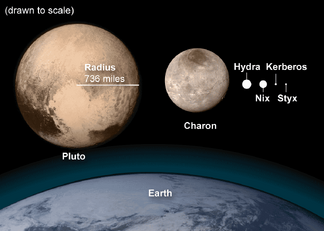No edit summary Tags: Visual edit apiedit |
No edit summary Tag: Visual edit |
||
| Line 1: | Line 1: | ||
| + | [[File:Pluto charon.png|thumb|324x324px]] |
||
Pluto, Charon, Nix and Hydra all have an abundance of water and nitrogen ice. However, these dwarf planets will get poor solar energy due to the distance from the sun. |
Pluto, Charon, Nix and Hydra all have an abundance of water and nitrogen ice. However, these dwarf planets will get poor solar energy due to the distance from the sun. |
||
Revision as of 00:32, 17 September 2018

Pluto, Charon, Nix and Hydra all have an abundance of water and nitrogen ice. However, these dwarf planets will get poor solar energy due to the distance from the sun.
Artificial Gravity
Due to the extremely weak gravity, it would be nice to have artificial gravity so people who inhabit these worlds will not be physically weak or have major health issues. This gravity might be provided by hollowing out these planetoids and increasing their rate of rotation. People would live on the inside.
A new human civilization
Colonists might not colonize these worlds until the next two to three hundred years. A plutonian civilization would be established underground and an outpost can be built.
Other Options
It is very likely that Pluto, Charon, and other dwarf planets and moons on the outer edge of the solar system contain large amounts of ice. When properly heated combined with a pressurized atmosphere, it would melt and create an ocean. Humans would have to be careful how much exactly they heat up considering they might accidentally create an ocean planet with no land to stand on. The only way for an ocean to be created would be to increase the greenhouse gas effect enough so the atmosphere could support liquid water. The most potent greenhouse gas, Sulfur Hexaflouride could be transported from Venus, Titan, and other thick atmosphere planets.